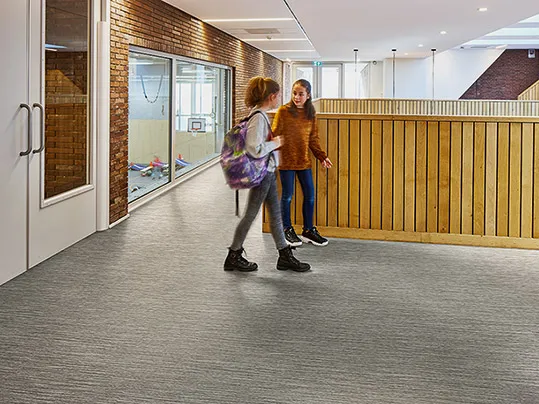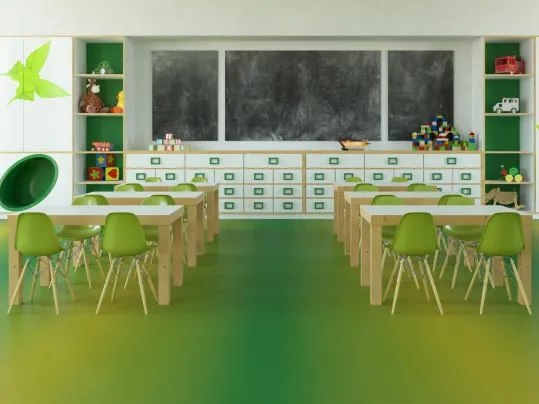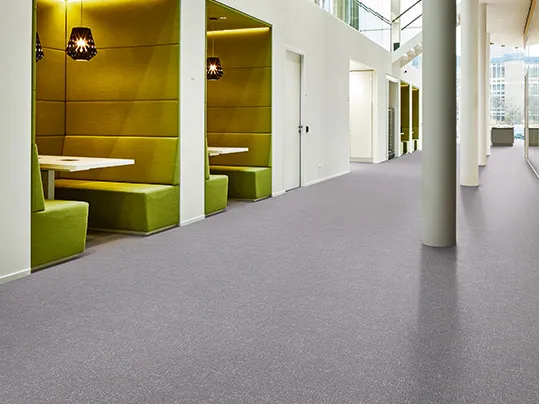Class in Session with Forbo: Acoustics
Lewis Cooper, Segment Marketing Manager for Education
January 2021
.png)
For specifiers, education facilities can pose something of a challenge when it comes to controlling noise. For one, school children can be very loud in both a vocal and a somatic sense and not always willing to quieten down should they be asked. But that’s not the only problem; many schools were built in an era (20th Century) where acoustic performance was not as well understood as it is now. As such, many classrooms up and down the country suffer from indoor environments that enhance excess reverberation and limit speech intelligibility. Unfortunately, the knock-on effects of this phenomena can be damaging. As well as adversely affecting the concentration levels of classroom occupants, poor acoustic management could also be contributing to a host of physical health problems in students.
To begin with, it’s important to distinguish the types of acoustic challenge that education facilities currently face. Concurrently, these facilities must look to improve levels of in-room sound absorption and impact sound reduction. The former refers to levels of sound intensity absorbed into different materials in a room, whilst the latter focuses on limiting the decibel level of certain impacts which can be heard in the floor levels below, such as footsteps or moving chairs.
At Forbo, we offer a portfolio of flooring solutions tackle the issue of impact sound reduction covering a variety of installation formats, finishes and designs to cater for every area of an educational establishment.

So, just how bad are things in education facilities? Well, one recent study found children sat in the fourth row of a classroom experience speech intelligibility rates of just 50 per cent ! In practice, this means that these students aren’t able to understand half of what their teacher says to them and will invariably miss out on crucial information that could help them in their coursework and exams. Likewise, noisy environments have been proven to increase the likelihood of sick days for those working within them. Within the private sector, it’s estimated that workers in noisy offices take 70% more sick days than those who work at home . If we assume the same applies to education facilities, then we might begin to better understand why even before COVID-19 teachers were taking 51,000 sick days a week .
This is not to say guidelines for acoustic specification in education facilities do not exist. In fact, within the UK, the Building Bulletin 93 is the most salient document for those looking to improve acoustic performance in classrooms. Published by the Department for Education in England, the document states the minimum performance standards for acoustics in schools and can help specifiers to create reasonably performing acoustic environments. However, as our understanding of acoustic performance improves, there’s an increasing demand for those designing such facilities to go above and beyond what’s legally required. As such, a new range of acoustic solutions are helping specifiers to ensure exceptional levels of speech intelligibility and listening comfort.

At Forbo, we’re leading this effort and doing our part to manufacture innovative acoustic flooring solutions that are perfectly suited for use across education facilities. Chief amongst these solutions is our Sarlon acoustic vinyl collection. Delivering ‘best in class’ acoustic vinyl flooring for all types of applications, solutions such as Sarlon offers a unique proposition.
As well as being designed and tested to maintain minimum residual indentation, the collection offers two levels of impact sound reduction: 15 dB and 19 dB. The latter represents the finest possible acoustic performance, making it a truly industry-leading product option. Within education facilities, the flooring is ideal for classroom use, as it helps to dampen interfering noises and improve levels of speech intelligibility.
What’s more, the acoustic vinyl range is also available in a wide-range of colour options and designs, to allow specifiers to create aesthetically pleasing classroom environments without having to compromise on performance.
Another great option is our Modul'up adhesive free vinyl. Available in a wide range of colours and designs, the durable solution can be laid quickly, eliminating all of the nuisance and lingering odour that is associated with an adhesive-based installation. What’s more, the flooring can be walked on immediately after it has been fitted, which helps to reduce downtime, and it can provide an impressive 19 dB impact sound reduction, making it ideal for busy areas such as corridors and circulation areas. .
Whilst sound reduction is an important consideration for specifiers working on education facilities, it’s also essential to not overlook other acoustic concerns, such as reverberation. If left unmanaged, reverberation can cause a problem for education facilities, but with the right oversight specifiers can harness it to improve listening comfort.
As such, specifiers should look to use acoustic materials with sound absorbing and diffusing properties, as well as those that allow for a small amount of reflection.
Of course, education facilities aren’t just all about classrooms. It’s also important for specifiers to address acoustic challenges in other areas, such as hallways.
Notoriously high-traffic areas, school hallways are routinely walked on by hundreds, if not thousands of individuals each day. As such, solutions such as our Tessera carpet tiles and Flotex flocked flooring, which are not only renowned for their aesthetic styling, but also for their outstanding performance in the most demanding environments, are ideal. Once again, like all solutions on offer at Forbo, these two products are available in an extensive collection of colours and designs, ensuring that education facilities never have to lose their sense of vibrancy.
What’s more, the solutions boast some impressive impact sound reduction ratings. Across the Tessera range, impact noise can be reduced between 23 dB and up to 30 dB. For those who want to achieve the upper range of those ratings, our Cloudscape SOFTbac® is the perfect solution. Similarly, to enhance the acoustic performance of our Flotex tiles we offer Flotex AcousticPlus: a special backing that increases the impact sound reduction with 3 dB to a total of 22 dB.

At Forbo, we understand that acoustic performance is an important component of designing education facilities and aim to make the concept easier to understand for specifiers and architects in the field. With our industry-leading acoustic flooring solutions, we’re able to do this and can help to deliver 'total solutions' for every project, assuring quality and accountability from a single supplier.
Download our schools design guide
Download our Tertiary Education Design Guide